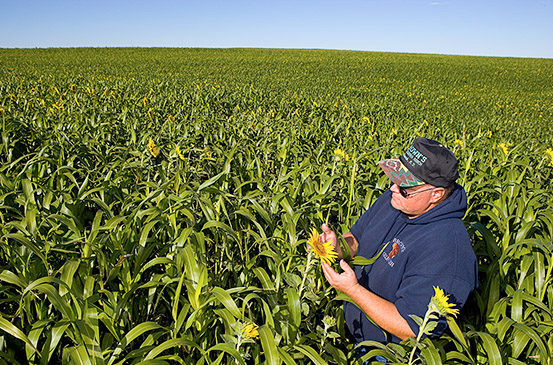
Gabe Brown
Brown’s Ranch, Bismarck, ND
Gabe Brown came to Regenerative Agriculture through hardship. In 1991 his in-laws retired and he took over their 1,760-acre farm outside Bismarck, North Dakota. He used the same practices they had used since the 1950s: tillage, fertilizers, pesticides and fungicides as well as conventional grazing practices. All of these were considered the highest standards in modern agriculture. But about five years later came four years of freak storms with resulting crop failures and the death of many of his cattle. He almost lost the farm at that point but chose instead to try to regenerate his failing enterprise using Holistic Management practices.
The idea, in some ways, was to go back to farming the way it used to be done a generation earlier, restoring and working with the natural ecological balance of the land. Improving soil health by not tilling and allowing the biomass left from the previous harvest to lie on the ground was the first step. That was actually the result of almost giving up in despair, but the surprising result was that when Brown tested his soil a few years later, leaving it alone had allowed the soil’s fertility to improve.
 Step by step, Gabe Brown included more Holistic Management/Regenerative Agriculture practices. Today he continues no-tilling, has added multi-species cover and companion crops, and has become an innovator in managed grazing techniques that allow most of his pastures a year of recovery time between feeding periods. By 2010 he had eliminated the use of synthetic fertilizers, and now he no longer needs to use fungicides and pesticides. Minimal amount of herbicides are used but he hopes to some day eliminate that as well. Each choice he made resulted in lower input costs, improved soil health, and eventually paid off in higher yields as well.
Step by step, Gabe Brown included more Holistic Management/Regenerative Agriculture practices. Today he continues no-tilling, has added multi-species cover and companion crops, and has become an innovator in managed grazing techniques that allow most of his pastures a year of recovery time between feeding periods. By 2010 he had eliminated the use of synthetic fertilizers, and now he no longer needs to use fungicides and pesticides. Minimal amount of herbicides are used but he hopes to some day eliminate that as well. Each choice he made resulted in lower input costs, improved soil health, and eventually paid off in higher yields as well.
Today, 20 years later, Brown has a highly successful 5000 acre ranch with crop yields 20-25 percent higher than the average yields in his county. His soil organic matter increased from 1.9 in 1991 to 6.1% and that has increased its water-infiltration rates tremendously. He was seeing rates of 1/2 inch per hour in 1991. Today it is 8 inches per hour. He also has done in-depth testing of his soil’s carbon-retention rates. His soils have 96 tons of carbon per acre in the top 48 inches. 10 to 30 tons of stored carbon is what is typical on conventionally farmed soils in the same region.
In this video from January 2021, Gabe Brown describes how using regenerative techniques saved his farm and how farmers can weather additional economic challenges today.
Gabe Brown is a strong proponent of soil health. He speaks widely at various events, gives farm tours, and presents seminars on Regenerative Agriculture. His book Dirt to Soil: One Family’s Journey into Regenerative Agriculture tells his story and is designed to be a guide for others. In it he shares in depth his five principles of soil health: no-till or minimal tillage, keeping the ground covered, diversity in plant and animal species, keeping living roots in the soil as much as possible, and the importance of integrating animals.
